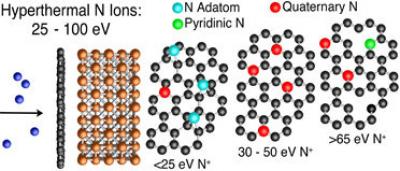A team of scientists at the U.S. Naval Research Laboratory (NRL) has demonstrated hyperthermal ion implantation (HyTII) as an effective means of doping graphene with nitrogen atoms. The result is a low-defect film with a tunable bandstructure that could be useful in a variety of device platforms and applications.

According to the research, the HyTII method delivers a high degree of control including doping concentration and, for the first time, demonstrates depth control of implantation by doping a single monolayer of graphene in a bilayer graphene stack. This further demonstrates that the resulting films have high-quality electronic transport properties that can be described solely by changes in bandstructure rather than the defect-dominated behavior of graphene films doped or functionalized using other methods.
Doping or chemical functionalization may add a usable transport gap to graphene, thus making it more suitable for various applications. However, common methods tend to produce films that are plagued by unintentional defects, have low stability, or non-uniform coverage of dopants and functional groups, which all greatly limit their usefulness and degrade the intrinsic desirable properties of the graphene film. As an alternative, NRL scientists developed this hyperthermal ion implantation system with the necessary precision and control to implant nitrogen (N+) into graphene achieving doping via direct substitution.
In their study, the team determined the range of hyperthermal ion energies that yielded the highest fraction of nitrogen doping, while minimizing defects, and were successful in confirming the inherent depth control of the HyTII process. To achieve the latter, the scientists implemented a bilayer graphene material system comprising a layer of natural graphene, with mostly carbon-12 (12C) atoms, layered on graphene synthesized with greater than 99% carbon-13 (13C). This bilayer material provided a means to identify which layer they were modifying when analyzed with Raman spectroscopy.
Devices made from films processed with N+ in the range of optimal doping show a transition from strong to weak localization that depends on implantation dose, indicating the implanted nitrogen’s ability to alter the intrinsic properties of the film. As further evidenced by the high electronic quality of the implanted devices over similar adatom-doped devices, the scientists found that the temperature dependence can be fit by a model that takes into account both band effects due to the substitutional doping and insulator-like effects due to defect formation, with the band effects observed to be the dominant component.
Surprisingly, the researchers found that a higher amount of nitrogen doping prevents the crossover to insulating behavior near the charge neutrality point. Defects appear to dominate the behavior only at large implantation energies, where defects are more probable, further demonstrating the differences between true-doped films and previous defective/doped films. The researchers stated that Our measurements of these devices strongly indicate that we have finally fabricated a graphene film with a tunable bandgap, low defect density, and high stability,. We therefore hypothesize that HyTII graphene films have great potential for electronic or spintronic applications for high-quality graphene where a transport or bandgap and high carrier concentration are desired.